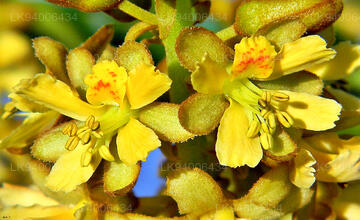
Ayurvedic Medicinal Plants
Sri Lanka's Ayurvedic tradition features a rich variety of medicinal plants used for centuries. Sri Lanka has a rich tradition of Ayurvedic medicine, drawing on its indigenous knowledge and a variety of medicinal plants. Here are some notable Ayurvedic medicinal plants found in Sri Lanka:
Caesalpinia bonduc
Caesalpinia bonduc, commonly known as grey nicker, nicker bean, fever nut or knicker nut, is a species of flowering plant in the senna tribe, Caesalpinieae, that has a pantropical distribution. It is a liana that reaches a length of 6 m (20 ft) or more and scrambles over other vegetation. The stems are covered in curved spines. Its 2 cm (0.8 in) grey seeds, known as nickernuts, are buoyant and durable enough to be dispersed by ocean currents.
The leaves are large and bi-pinnate, up to 40 cm (16 in) long with scattered prickles on the rachises and blades. There are four to eleven pairs of pinnae, 5 to 20 cm (2 to 8 in) long with five to ten pairs of pinnules. The pinnules are 15 to 40 mm (0.6 to 1.6 in) long, elliptic, oblong or ovate with acute tips and entire margins. The inflorescence is an axillary raceme, often branched, covered with short hairs and up to 15 cm (6 in) long. The jointed pedicels are up to 6 mm (0.2 in) long. The sepals are shorter than the petals which are around 10 mm (0.4 in) long; the petals are yellow, sometimes with a spot of orange near the base of the keel. The flowers are followed by large, flattish, spiny green pods which later turn brown, some 9 by 4 cm (4 by 2 in), containing one or usually two, glossy, rounded, grey seeds.
This plant has been used in traditional medicine. The seeds have tonic and antipyretic properties and the bark and leaves have been used to lower fevers. An oil extracted from the seeds has been used in cosmetics and for treating discharges from the ear.
As well as uses Caesalpinia bonducas amedicine for Piles, Paralysis, Fevers, Coughs,Worm diseases, Dysentery and Pimples.
-

Ankenda
Acronychia pedunculata -

Beli
Aegle marmelos -

Bakmi
Nauclea orientalis -

Bangwel-geta
Coscinium fenestratum -

Bukinda /Walkinda
Tinospora malabarica -

Bu- kobbe
Allophylus cobbe -

Dodan –kaha
Memecylon capitellatum -

Diyamitta
Cissampelos pareira -

Embul dodan
Citrus aurantium -

Gas nidikumba
Biophytun reinward -

Hintambala
Carmona microphylla -

Goraka
Garcinia cambogia -

Karapincha
Murraya koenigii -

Keppetiya
Croton laccifer -

Kohomba
Azadirachta indica -

Kotikan-bevila
Sida alba -

Kudumiris (Forest paper)
Toddlia asiatica -

Kurundu
Cinnamomum zeylanicum -

Mahakaramba
Carissa carandas -

Muna mal
Mimusops elengi -

Nelli
Phyltanthus emblica -

Puwak
Areca catechu -

Rath mal
Ixora coccinea -

Eepatta / Ruk - anguna
Alangium salviifolium -

Siyambala
Tamarindus indica -

Walangasal / Wal-embilla
Embelia ribes -

Wal Karapincha
Micromelum ceylanicum -

Welangiriya
Paramignya monophylla
Ayurvedic and Herbal
-
Siddhalepa 阿育吠陀草本香膏
常规价格 来自 $11.00 TWD常规价格单价 / 单价$13.00 TWD促销价 来自 $11.00 TWD促销 -
Lakpura 脱水刺五加(瓜纳巴纳、格拉维奥拉、圭亚巴诺)叶子
常规价格 来自 $102.00 TWD常规价格单价 / 单价$73.00 TWD促销价 来自 $102.00 TWD -
链接 Swastha Thriphala(30 片)
常规价格 来自 $64.00 TWD常规价格单价 / 单价$76.00 TWD促销价 来自 $64.00 TWD促销 -
Sethsuwa Pranajeewa 奇迹油
常规价格 来自 $108.00 TWD常规价格单价 / 单价$128.00 TWD促销价 来自 $108.00 TWD促销

















































